BUS5SMM - Green Marketing & Consumer Behavior: Annotated Bibliography
VerifiedAdded on 2023/04/28
|6
|1671
|122
Annotated Bibliography
AI Summary
This annotated bibliography examines the influence of green marketing on consumer behavior, referencing five key articles. The first article analyzes the impact of green marketing on customer behavior in the hotel industry, highlighting the roles of green trust and attitudinal loyalty. The second provides a basis for analyzing variables impacting consumer buying behavior through green marketing. The third clarifies female consumers' attitudes toward green cosmetics, considering factors like pricing and recommendations. The fourth explores how environmental values and emotion in green marketing communications induce sustainable consumer behavior. Finally, the fifth evaluates the factors influencing young consumers' environmental beliefs and green purchasing behavior. Each annotation summarizes the article's scope, research methods, relevance, strengths, limitations, and conclusion, along with a personal reflection.
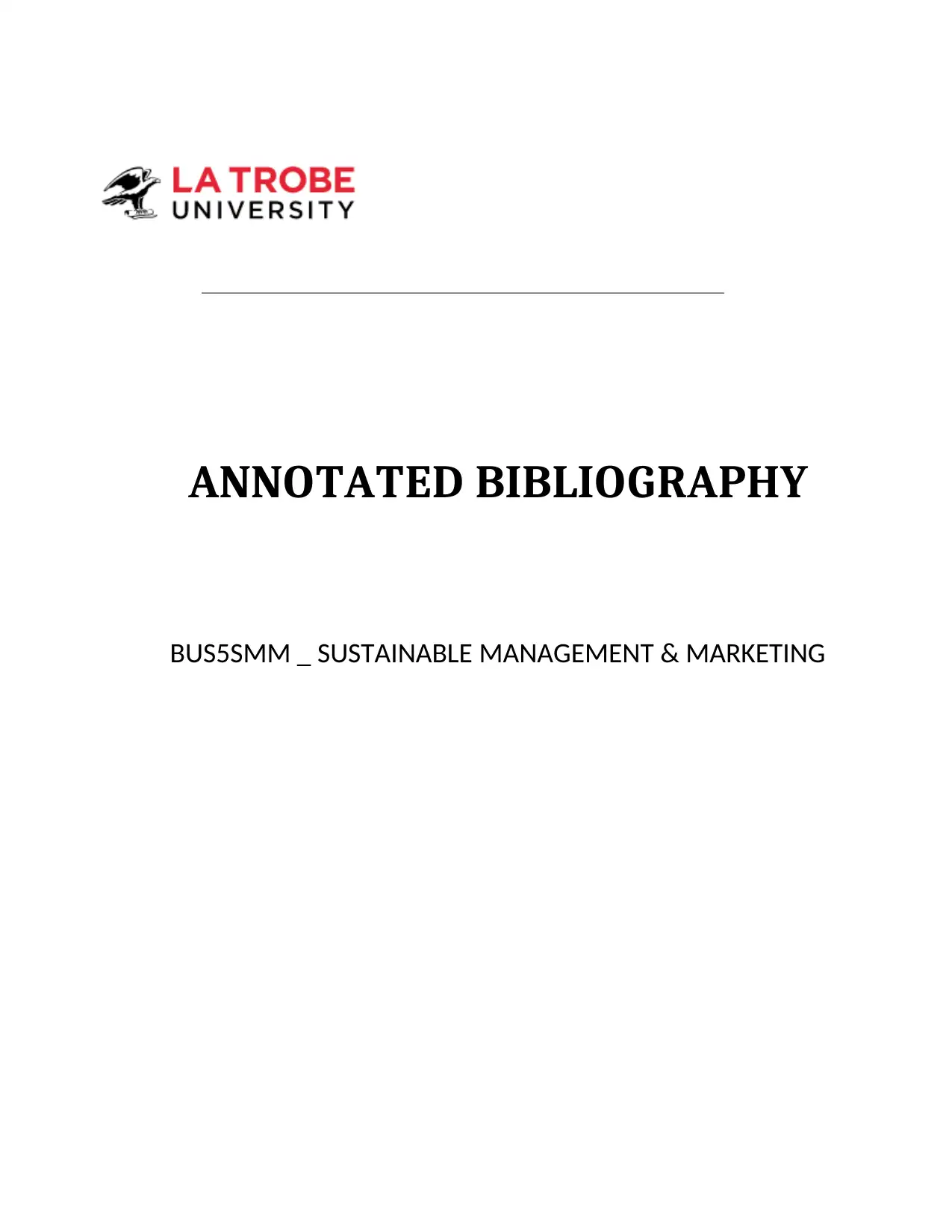
ANNOTATED BIBLIOGRAPHY
BUS5SMM _ SUSTAINABLE MANAGEMENT & MARKETING
BUS5SMM _ SUSTAINABLE MANAGEMENT & MARKETING
Paraphrase This Document
Need a fresh take? Get an instant paraphrase of this document with our AI Paraphraser
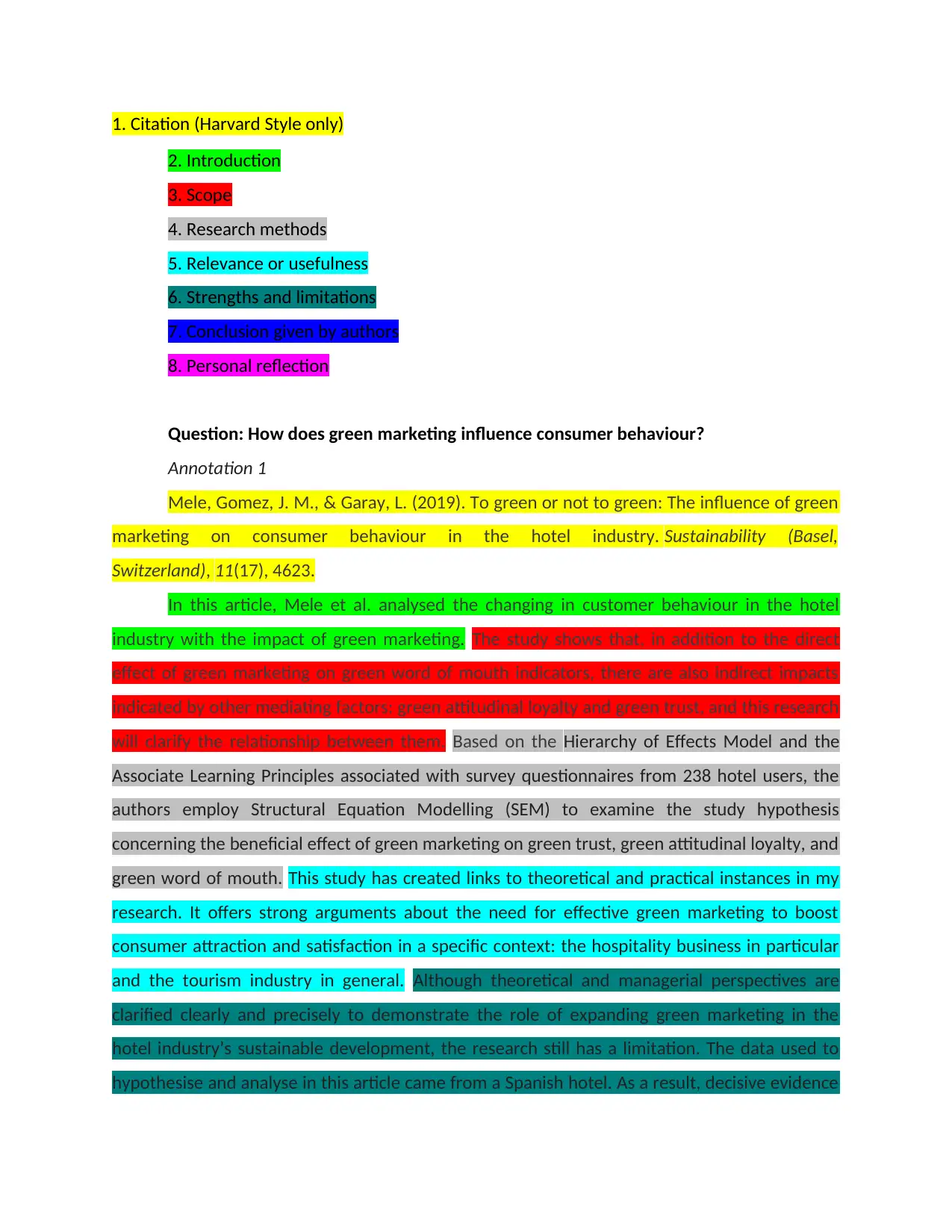
1. Citation (Harvard Style only)
2. Introduction
3. Scope
4. Research methods
5. Relevance or usefulness
6. Strengths and limitations
7. Conclusion given by authors
8. Personal reflection
Question: How does green marketing influence consumer behaviour?
Annotation 1
Mele, Gomez, J. M., & Garay, L. (2019). To green or not to green: The influence of green
marketing on consumer behaviour in the hotel industry. Sustainability (Basel,
Switzerland), 11(17), 4623.
In this article, Mele et al. analysed the changing in customer behaviour in the hotel
industry with the impact of green marketing. The study shows that, in addition to the direct
effect of green marketing on green word of mouth indicators, there are also indirect impacts
indicated by other mediating factors: green attitudinal loyalty and green trust, and this research
will clarify the relationship between them. Based on the Hierarchy of Effects Model and the
Associate Learning Principles associated with survey questionnaires from 238 hotel users, the
authors employ Structural Equation Modelling (SEM) to examine the study hypothesis
concerning the beneficial effect of green marketing on green trust, green attitudinal loyalty, and
green word of mouth. This study has created links to theoretical and practical instances in my
research. It offers strong arguments about the need for effective green marketing to boost
consumer attraction and satisfaction in a specific context: the hospitality business in particular
and the tourism industry in general. Although theoretical and managerial perspectives are
clarified clearly and precisely to demonstrate the role of expanding green marketing in the
hotel industry’s sustainable development, the research still has a limitation. The data used to
hypothesise and analyse in this article came from a Spanish hotel. As a result, decisive evidence
2. Introduction
3. Scope
4. Research methods
5. Relevance or usefulness
6. Strengths and limitations
7. Conclusion given by authors
8. Personal reflection
Question: How does green marketing influence consumer behaviour?
Annotation 1
Mele, Gomez, J. M., & Garay, L. (2019). To green or not to green: The influence of green
marketing on consumer behaviour in the hotel industry. Sustainability (Basel,
Switzerland), 11(17), 4623.
In this article, Mele et al. analysed the changing in customer behaviour in the hotel
industry with the impact of green marketing. The study shows that, in addition to the direct
effect of green marketing on green word of mouth indicators, there are also indirect impacts
indicated by other mediating factors: green attitudinal loyalty and green trust, and this research
will clarify the relationship between them. Based on the Hierarchy of Effects Model and the
Associate Learning Principles associated with survey questionnaires from 238 hotel users, the
authors employ Structural Equation Modelling (SEM) to examine the study hypothesis
concerning the beneficial effect of green marketing on green trust, green attitudinal loyalty, and
green word of mouth. This study has created links to theoretical and practical instances in my
research. It offers strong arguments about the need for effective green marketing to boost
consumer attraction and satisfaction in a specific context: the hospitality business in particular
and the tourism industry in general. Although theoretical and managerial perspectives are
clarified clearly and precisely to demonstrate the role of expanding green marketing in the
hotel industry’s sustainable development, the research still has a limitation. The data used to
hypothesise and analyse in this article came from a Spanish hotel. As a result, decisive evidence
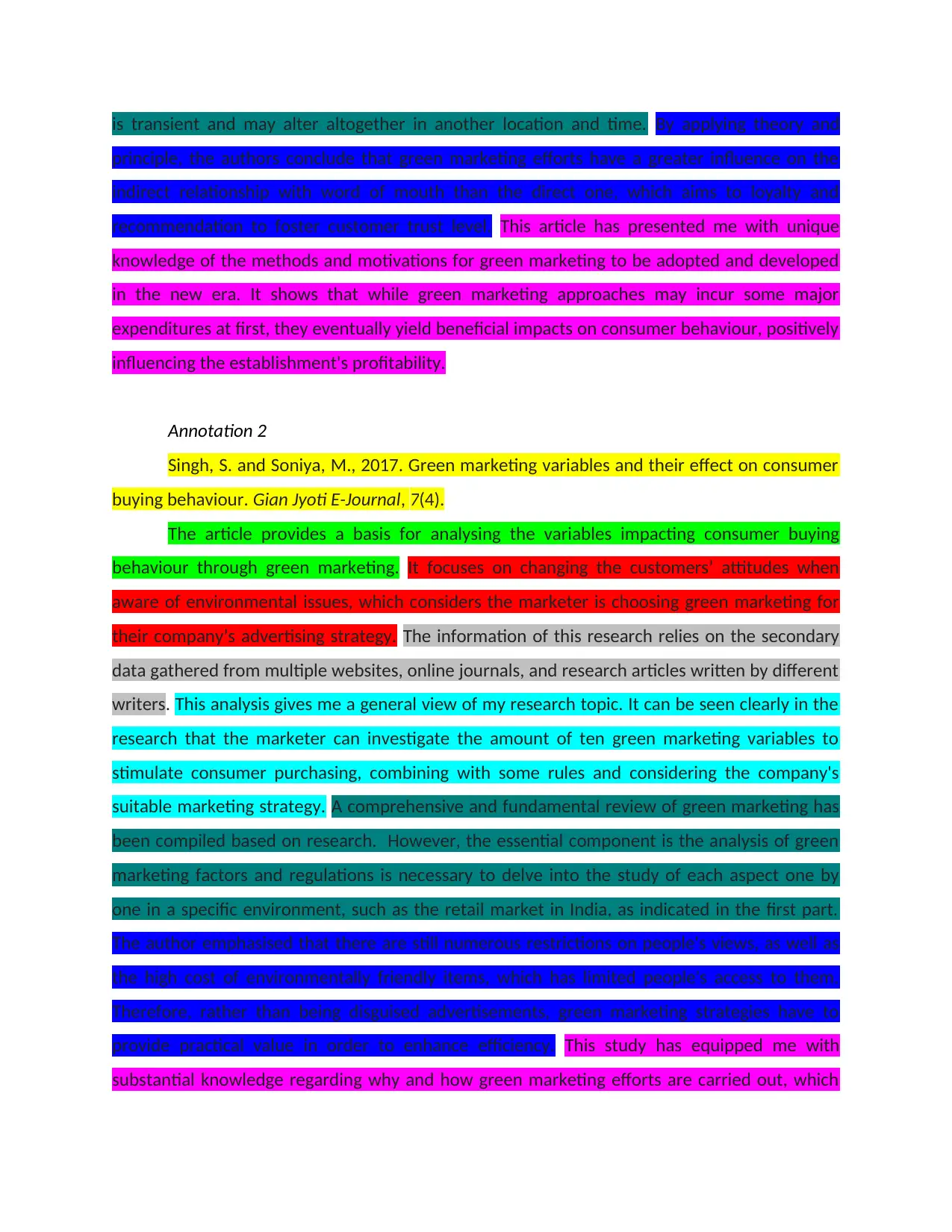
is transient and may alter altogether in another location and time. By applying theory and
principle, the authors conclude that green marketing efforts have a greater influence on the
indirect relationship with word of mouth than the direct one, which aims to loyalty and
recommendation to foster customer trust level. This article has presented me with unique
knowledge of the methods and motivations for green marketing to be adopted and developed
in the new era. It shows that while green marketing approaches may incur some major
expenditures at first, they eventually yield beneficial impacts on consumer behaviour, positively
influencing the establishment's profitability.
Annotation 2
Singh, S. and Soniya, M., 2017. Green marketing variables and their effect on consumer
buying behaviour. Gian Jyoti E-Journal, 7(4).
The article provides a basis for analysing the variables impacting consumer buying
behaviour through green marketing. It focuses on changing the customers’ attitudes when
aware of environmental issues, which considers the marketer is choosing green marketing for
their company’s advertising strategy. The information of this research relies on the secondary
data gathered from multiple websites, online journals, and research articles written by different
writers. This analysis gives me a general view of my research topic. It can be seen clearly in the
research that the marketer can investigate the amount of ten green marketing variables to
stimulate consumer purchasing, combining with some rules and considering the company's
suitable marketing strategy. A comprehensive and fundamental review of green marketing has
been compiled based on research. However, the essential component is the analysis of green
marketing factors and regulations is necessary to delve into the study of each aspect one by
one in a specific environment, such as the retail market in India, as indicated in the first part.
The author emphasised that there are still numerous restrictions on people's views, as well as
the high cost of environmentally friendly items, which has limited people's access to them.
Therefore, rather than being disguised advertisements, green marketing strategies have to
provide practical value in order to enhance efficiency. This study has equipped me with
substantial knowledge regarding why and how green marketing efforts are carried out, which
principle, the authors conclude that green marketing efforts have a greater influence on the
indirect relationship with word of mouth than the direct one, which aims to loyalty and
recommendation to foster customer trust level. This article has presented me with unique
knowledge of the methods and motivations for green marketing to be adopted and developed
in the new era. It shows that while green marketing approaches may incur some major
expenditures at first, they eventually yield beneficial impacts on consumer behaviour, positively
influencing the establishment's profitability.
Annotation 2
Singh, S. and Soniya, M., 2017. Green marketing variables and their effect on consumer
buying behaviour. Gian Jyoti E-Journal, 7(4).
The article provides a basis for analysing the variables impacting consumer buying
behaviour through green marketing. It focuses on changing the customers’ attitudes when
aware of environmental issues, which considers the marketer is choosing green marketing for
their company’s advertising strategy. The information of this research relies on the secondary
data gathered from multiple websites, online journals, and research articles written by different
writers. This analysis gives me a general view of my research topic. It can be seen clearly in the
research that the marketer can investigate the amount of ten green marketing variables to
stimulate consumer purchasing, combining with some rules and considering the company's
suitable marketing strategy. A comprehensive and fundamental review of green marketing has
been compiled based on research. However, the essential component is the analysis of green
marketing factors and regulations is necessary to delve into the study of each aspect one by
one in a specific environment, such as the retail market in India, as indicated in the first part.
The author emphasised that there are still numerous restrictions on people's views, as well as
the high cost of environmentally friendly items, which has limited people's access to them.
Therefore, rather than being disguised advertisements, green marketing strategies have to
provide practical value in order to enhance efficiency. This study has equipped me with
substantial knowledge regarding why and how green marketing efforts are carried out, which
⊘ This is a preview!⊘
Do you want full access?
Subscribe today to unlock all pages.

Trusted by 1+ million students worldwide
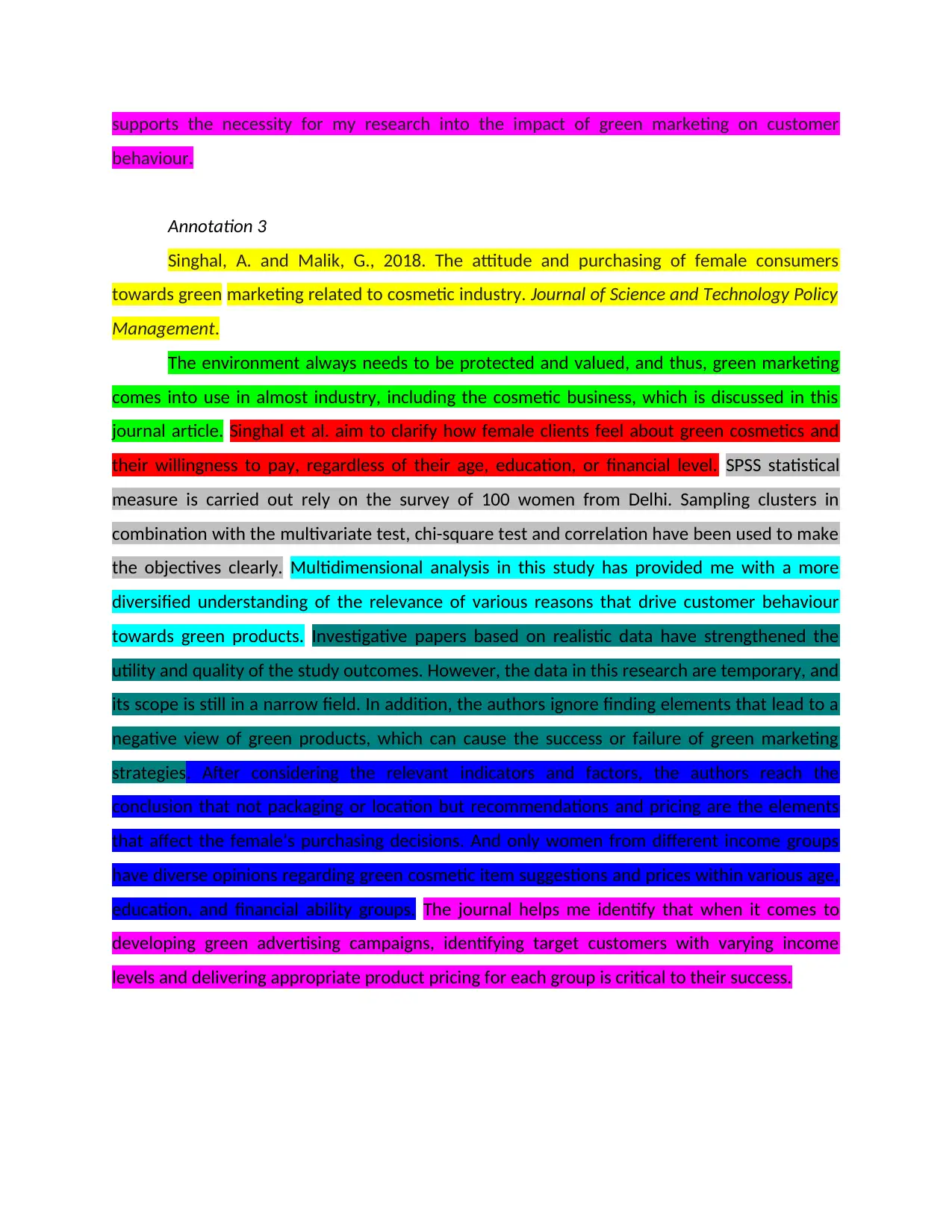
supports the necessity for my research into the impact of green marketing on customer
behaviour.
Annotation 3
Singhal, A. and Malik, G., 2018. The attitude and purchasing of female consumers
towards green marketing related to cosmetic industry. Journal of Science and Technology Policy
Management.
The environment always needs to be protected and valued, and thus, green marketing
comes into use in almost industry, including the cosmetic business, which is discussed in this
journal article. Singhal et al. aim to clarify how female clients feel about green cosmetics and
their willingness to pay, regardless of their age, education, or financial level. SPSS statistical
measure is carried out rely on the survey of 100 women from Delhi. Sampling clusters in
combination with the multivariate test, chi-square test and correlation have been used to make
the objectives clearly. Multidimensional analysis in this study has provided me with a more
diversified understanding of the relevance of various reasons that drive customer behaviour
towards green products. Investigative papers based on realistic data have strengthened the
utility and quality of the study outcomes. However, the data in this research are temporary, and
its scope is still in a narrow field. In addition, the authors ignore finding elements that lead to a
negative view of green products, which can cause the success or failure of green marketing
strategies. After considering the relevant indicators and factors, the authors reach the
conclusion that not packaging or location but recommendations and pricing are the elements
that affect the female’s purchasing decisions. And only women from different income groups
have diverse opinions regarding green cosmetic item suggestions and prices within various age,
education, and financial ability groups. The journal helps me identify that when it comes to
developing green advertising campaigns, identifying target customers with varying income
levels and delivering appropriate product pricing for each group is critical to their success.
behaviour.
Annotation 3
Singhal, A. and Malik, G., 2018. The attitude and purchasing of female consumers
towards green marketing related to cosmetic industry. Journal of Science and Technology Policy
Management.
The environment always needs to be protected and valued, and thus, green marketing
comes into use in almost industry, including the cosmetic business, which is discussed in this
journal article. Singhal et al. aim to clarify how female clients feel about green cosmetics and
their willingness to pay, regardless of their age, education, or financial level. SPSS statistical
measure is carried out rely on the survey of 100 women from Delhi. Sampling clusters in
combination with the multivariate test, chi-square test and correlation have been used to make
the objectives clearly. Multidimensional analysis in this study has provided me with a more
diversified understanding of the relevance of various reasons that drive customer behaviour
towards green products. Investigative papers based on realistic data have strengthened the
utility and quality of the study outcomes. However, the data in this research are temporary, and
its scope is still in a narrow field. In addition, the authors ignore finding elements that lead to a
negative view of green products, which can cause the success or failure of green marketing
strategies. After considering the relevant indicators and factors, the authors reach the
conclusion that not packaging or location but recommendations and pricing are the elements
that affect the female’s purchasing decisions. And only women from different income groups
have diverse opinions regarding green cosmetic item suggestions and prices within various age,
education, and financial ability groups. The journal helps me identify that when it comes to
developing green advertising campaigns, identifying target customers with varying income
levels and delivering appropriate product pricing for each group is critical to their success.
Paraphrase This Document
Need a fresh take? Get an instant paraphrase of this document with our AI Paraphraser
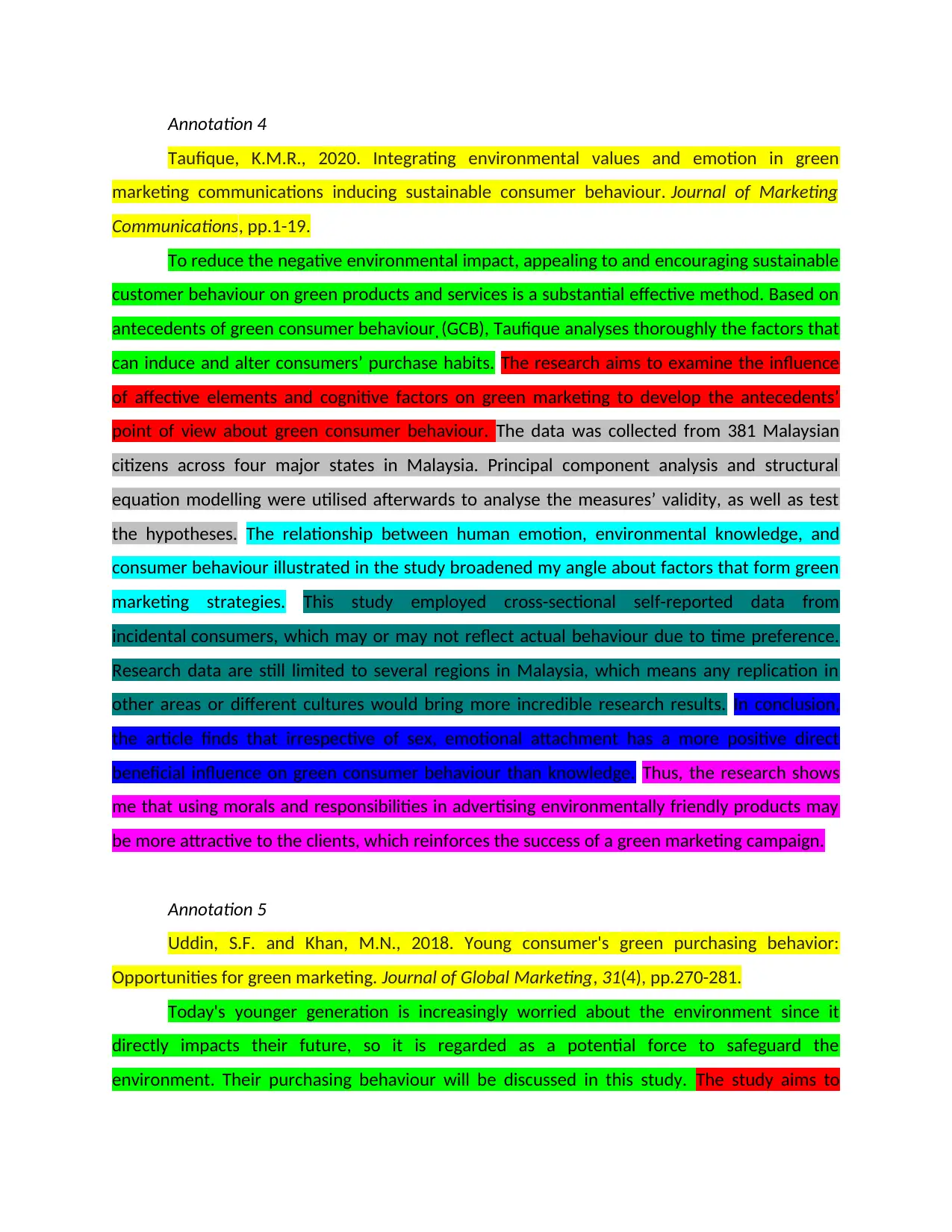
Annotation 4
Taufique, K.M.R., 2020. Integrating environmental values and emotion in green
marketing communications inducing sustainable consumer behaviour. Journal of Marketing
Communications, pp.1-19.
To reduce the negative environmental impact, appealing to and encouraging sustainable
customer behaviour on green products and services is a substantial effective method. Based on
antecedents of green consumer behaviour (GCB), Taufique analyses thoroughly the factors that ̣
can induce and alter consumers’ purchase habits. The research aims to examine the influence
of affective elements and cognitive factors on green marketing to develop the antecedents’
point of view about green consumer behaviour. The data was collected from 381 Malaysian
citizens across four major states in Malaysia. Principal component analysis and structural
equation modelling were utilised afterwards to analyse the measures’ validity, as well as test
the hypotheses. The relationship between human emotion, environmental knowledge, and
consumer behaviour illustrated in the study broadened my angle about factors that form green
marketing strategies. This study employed cross-sectional self-reported data from
incidental consumers, which may or may not reflect actual behaviour due to time preference.
Research data are still limited to several regions in Malaysia, which means any replication in
other areas or different cultures would bring more incredible research results. In conclusion,
the article finds that irrespective of sex, emotional attachment has a more positive direct
beneficial influence on green consumer behaviour than knowledge. Thus, the research shows
me that using morals and responsibilities in advertising environmentally friendly products may
be more attractive to the clients, which reinforces the success of a green marketing campaign.
Annotation 5
Uddin, S.F. and Khan, M.N., 2018. Young consumer's green purchasing behavior:
Opportunities for green marketing. Journal of Global Marketing, 31(4), pp.270-281.
Today's younger generation is increasingly worried about the environment since it
directly impacts their future, so it is regarded as a potential force to safeguard the
environment. Their purchasing behaviour will be discussed in this study. The study aims to
Taufique, K.M.R., 2020. Integrating environmental values and emotion in green
marketing communications inducing sustainable consumer behaviour. Journal of Marketing
Communications, pp.1-19.
To reduce the negative environmental impact, appealing to and encouraging sustainable
customer behaviour on green products and services is a substantial effective method. Based on
antecedents of green consumer behaviour (GCB), Taufique analyses thoroughly the factors that ̣
can induce and alter consumers’ purchase habits. The research aims to examine the influence
of affective elements and cognitive factors on green marketing to develop the antecedents’
point of view about green consumer behaviour. The data was collected from 381 Malaysian
citizens across four major states in Malaysia. Principal component analysis and structural
equation modelling were utilised afterwards to analyse the measures’ validity, as well as test
the hypotheses. The relationship between human emotion, environmental knowledge, and
consumer behaviour illustrated in the study broadened my angle about factors that form green
marketing strategies. This study employed cross-sectional self-reported data from
incidental consumers, which may or may not reflect actual behaviour due to time preference.
Research data are still limited to several regions in Malaysia, which means any replication in
other areas or different cultures would bring more incredible research results. In conclusion,
the article finds that irrespective of sex, emotional attachment has a more positive direct
beneficial influence on green consumer behaviour than knowledge. Thus, the research shows
me that using morals and responsibilities in advertising environmentally friendly products may
be more attractive to the clients, which reinforces the success of a green marketing campaign.
Annotation 5
Uddin, S.F. and Khan, M.N., 2018. Young consumer's green purchasing behavior:
Opportunities for green marketing. Journal of Global Marketing, 31(4), pp.270-281.
Today's younger generation is increasingly worried about the environment since it
directly impacts their future, so it is regarded as a potential force to safeguard the
environment. Their purchasing behaviour will be discussed in this study. The study aims to
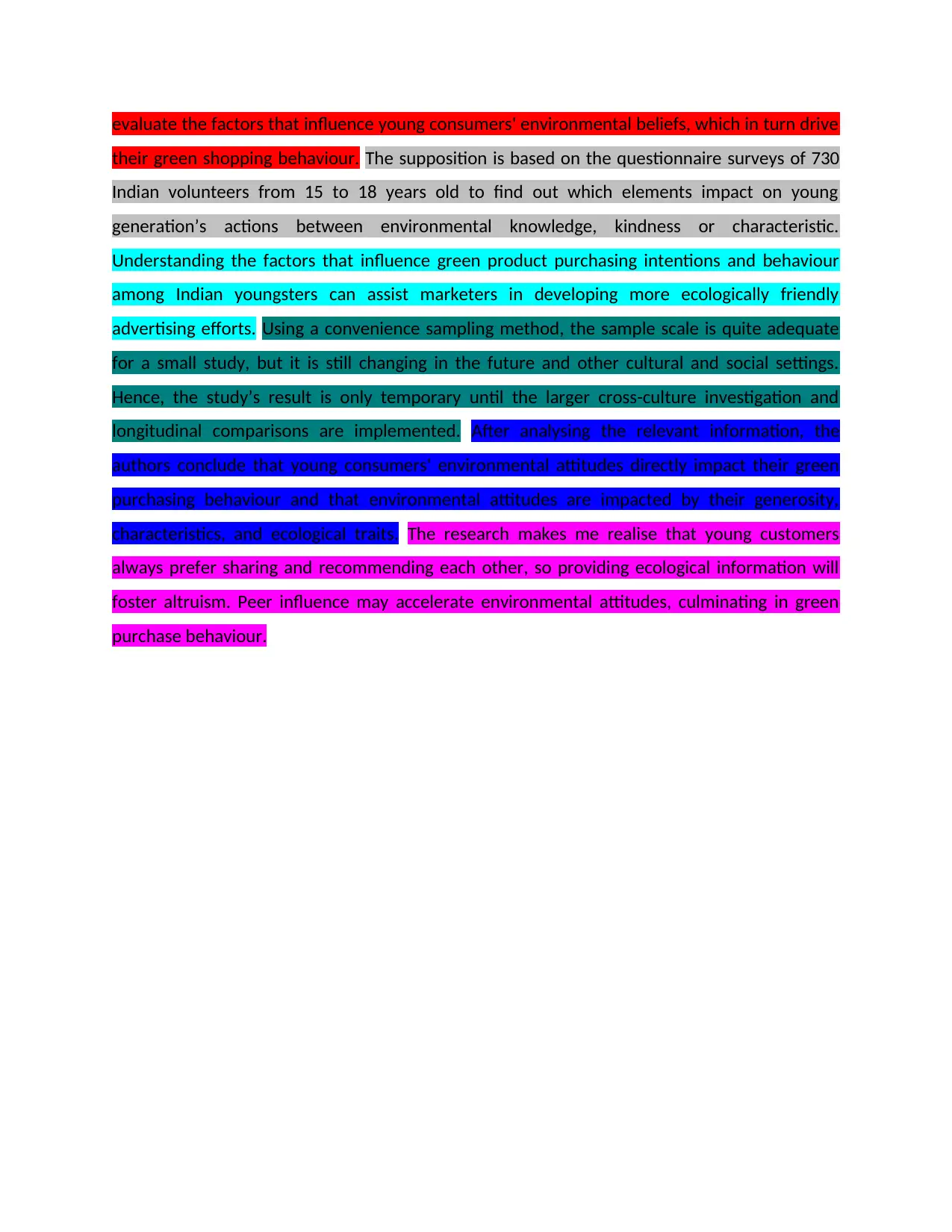
evaluate the factors that influence young consumers' environmental beliefs, which in turn drive
their green shopping behaviour. The supposition is based on the questionnaire surveys of 730
Indian volunteers from 15 to 18 years old to find out which elements impact on young
generation’s actions between environmental knowledge, kindness or characteristic.
Understanding the factors that influence green product purchasing intentions and behaviour
among Indian youngsters can assist marketers in developing more ecologically friendly
advertising efforts. Using a convenience sampling method, the sample scale is quite adequate
for a small study, but it is still changing in the future and other cultural and social settings.
Hence, the study’s result is only temporary until the larger cross-culture investigation and
longitudinal comparisons are implemented. After analysing the relevant information, the
authors conclude that young consumers' environmental attitudes directly impact their green
purchasing behaviour and that environmental attitudes are impacted by their generosity,
characteristics, and ecological traits. The research makes me realise that young customers
always prefer sharing and recommending each other, so providing ecological information will
foster altruism. Peer influence may accelerate environmental attitudes, culminating in green
purchase behaviour.
their green shopping behaviour. The supposition is based on the questionnaire surveys of 730
Indian volunteers from 15 to 18 years old to find out which elements impact on young
generation’s actions between environmental knowledge, kindness or characteristic.
Understanding the factors that influence green product purchasing intentions and behaviour
among Indian youngsters can assist marketers in developing more ecologically friendly
advertising efforts. Using a convenience sampling method, the sample scale is quite adequate
for a small study, but it is still changing in the future and other cultural and social settings.
Hence, the study’s result is only temporary until the larger cross-culture investigation and
longitudinal comparisons are implemented. After analysing the relevant information, the
authors conclude that young consumers' environmental attitudes directly impact their green
purchasing behaviour and that environmental attitudes are impacted by their generosity,
characteristics, and ecological traits. The research makes me realise that young customers
always prefer sharing and recommending each other, so providing ecological information will
foster altruism. Peer influence may accelerate environmental attitudes, culminating in green
purchase behaviour.
⊘ This is a preview!⊘
Do you want full access?
Subscribe today to unlock all pages.

Trusted by 1+ million students worldwide
1 out of 6
Related Documents
Your All-in-One AI-Powered Toolkit for Academic Success.
+13062052269
info@desklib.com
Available 24*7 on WhatsApp / Email
![[object Object]](/_next/static/media/star-bottom.7253800d.svg)
Unlock your academic potential
Copyright © 2020–2025 A2Z Services. All Rights Reserved. Developed and managed by ZUCOL.




